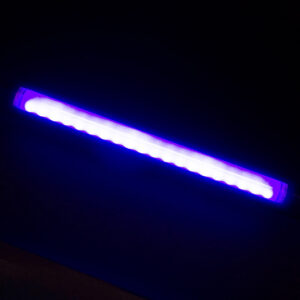 By: Laurie Neilsen
By: Laurie Neilsen
When many people think of UV lights or black lights, they think of posters in college dorm rooms, or spooky Halloween displays. Ultraviolet light, however, is an important subject of scientific study. Occupying the segment of the electromagnetic wavelength spectrum between 10 nm and 400 nm, Ultraviolet light is invisible to the human eye. UV lights are often referred to as “black” lights because of this.
The UV Flashlights available from Educational Innovations emit long-wave UV light at 385 nm. When the invisible ultraviolet light shines on a fluorescent substance, the light emitted is slightly less energetic. The loss of energy lengthens the wavelength of the light, bringing it above 400 nm, and into the visible spectrum. Materials which have this reaction to UV light are all around us in our daily lives.
 I went home one day with one of our 18 inch LED Ultraviolet Lights to make note of what in my apartment does and does not fluoresce. Some were items I expected, like white paper. Many of my books and many of the labels on products throughout my home glowed brightly under the UV light. Likewise, many white fabrics also fluoresced, including dryer sheets and some old insulation around our doorways. The text on one of my posters seemed to nearly jump off the paper, even though it is not a poster designed to make college students say “whoa.”
I went home one day with one of our 18 inch LED Ultraviolet Lights to make note of what in my apartment does and does not fluoresce. Some were items I expected, like white paper. Many of my books and many of the labels on products throughout my home glowed brightly under the UV light. Likewise, many white fabrics also fluoresced, including dryer sheets and some old insulation around our doorways. The text on one of my posters seemed to nearly jump off the paper, even though it is not a poster designed to make college students say “whoa.”
I was not surprised to find that many items commonly called “neon” glow under a blacklight. There were several Lego pieces which glowed quite brightly, usually the headlights on the vehicles. Any brightly colored labels or plastic packaging lit up, as did some clear plastic packages. I was surprised to see thatsome of the glasses in my cupboard seemed to glow faintly, usually those with thick bottoms.
A trip into my pantry revealed a few surprises. Both shortening and canola oil reacted to the light, as did tonic water. The bright packaging of my cheese snacks reacted, but the cheese snacks themselves did not glow as brightly as I thought they might. I knew that liquid detergent is reactive to UV light, but I use powder detergent. Although it did not all glow, there were several brightly glowing particles within the detergent. I wonder if this is what is used to make white clothes look whiter.
I looked into my jewelry box to see that a few of the beads were glowing. I have a necklace from the people who bring us our Real Cool Bugs. Mine has a green chafer beetle in it, whose eyes apparently react to UV light. It looked as if I had somehow turned its little headlights on.
As I wandered through the apartment, I noticed that the dust (in what I thought was a pretty clean apartment) was glowing under the UV light. I turned the flashlight on my skin, and saw that I fluoresce as well. Perhaps I should get out in sunlight a little more often.
Remembering far too many crime shows from television, I turned the light on my floor. I saw something glowing brightly on one of the rugs. With the lights on, there appeared to be nothing there. I am assuming the crime that took place there involved a ball of fur escaping the confines of my cat’s stomach. I then made the grave mistake of turning the light on my tub and sink in the bathroom. Do yourself a favor, and never look at your tub in the dark with a UV light. I’m hoping soap scum was the reason for the streaks and spots that I saw. If I ever want to sleep again, that was just soap scum.
Having explored most of my home, I turned the UV light onto the walls. I could clearly see the spots where holes in the plaster walls were filled in, and possibly painted over with new paint. The old paint on the walls had no reaction at all to the light, despite being white paint. Newer paint has brighteners that cause a reaction to UV light. Considering how old the house is, and how much the plaster walls tend to break apart in big chunks when drilled into, a UV light could be a handy tool in finding places where a hole might be easier to drill.
Science is about asking questions and finding answers. Therefore, the Scientific Process requires a healthy dose of curiosity. Send your students on their own ultraviolet scavenger hunts, and see what they find. The answers may surprise you.
Really appreciate you sharing this post.Much thanks again. Fantastic.